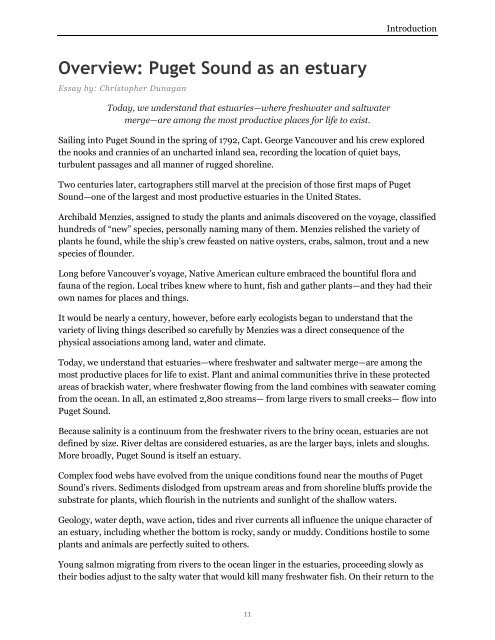Create successful ePaper yourself
Turn your PDF publications into a flip-book with our unique Google optimized e-Paper software.
Introduction<br />
Overview: <strong>Puget</strong> <strong>Sound</strong> as an estuary<br />
Essay by: Christopher Dunagan<br />
Today, we understand that estuaries—where freshwater and saltwater<br />
merge—are among <strong>the</strong> most productive places for life to exist.<br />
Sailing into <strong>Puget</strong> <strong>Sound</strong> in <strong>the</strong> spring of 1792, Capt. George Vancouver and his crew explored<br />
<strong>the</strong> nooks and crannies of an uncharted inland sea, recording <strong>the</strong> location of quiet bays,<br />
turbulent passages and all manner of rugged shoreline.<br />
Two centuries later, cartographers still marvel at <strong>the</strong> precision of those first maps of <strong>Puget</strong><br />
<strong>Sound</strong>—one of <strong>the</strong> largest and most productive estuaries in <strong>the</strong> United States.<br />
Archibald Menzies, assigned to study <strong>the</strong> plants and animals discovered on <strong>the</strong> voyage, classified<br />
hundreds of “new” species, personally naming many of <strong>the</strong>m. Menzies relished <strong>the</strong> variety of<br />
plants he found, while <strong>the</strong> ship’s crew feasted on native oysters, crabs, salmon, trout and a new<br />
species of flounder.<br />
Long before Vancouver’s voyage, Native American culture embraced <strong>the</strong> bountiful flora and<br />
fauna of <strong>the</strong> region. Local tribes knew where to hunt, fish and ga<strong>the</strong>r plants—and <strong>the</strong>y had <strong>the</strong>ir<br />
own names for places and things.<br />
It would be nearly a century, however, before early ecologists began to understand that <strong>the</strong><br />
variety of living things described so carefully by Menzies was a direct consequence of <strong>the</strong><br />
physical associations among land, water and climate.<br />
Today, we understand that estuaries—where freshwater and saltwater merge—are among <strong>the</strong><br />
most productive places for life to exist. Plant and animal communities thrive in <strong>the</strong>se protected<br />
areas of brackish water, where freshwater flowing from <strong>the</strong> land combines with seawater coming<br />
from <strong>the</strong> ocean. In all, an estimated 2,800 streams— from large rivers to small creeks— flow into<br />
<strong>Puget</strong> <strong>Sound</strong>.<br />
Because salinity is a continuum from <strong>the</strong> freshwater rivers to <strong>the</strong> briny ocean, estuaries are not<br />
defined by size. River deltas are considered estuaries, as are <strong>the</strong> larger bays, inlets and sloughs.<br />
More broadly, <strong>Puget</strong> <strong>Sound</strong> is itself an estuary.<br />
Complex food webs have evolved from <strong>the</strong> unique conditions found near <strong>the</strong> mouths of <strong>Puget</strong><br />
<strong>Sound</strong>’s rivers. Sediments dislodged from upstream areas and from shoreline bluffs provide <strong>the</strong><br />
substrate for plants, which flourish in <strong>the</strong> nutrients and sunlight of <strong>the</strong> shallow waters.<br />
Geology, water depth, wave action, tides and river currents all influence <strong>the</strong> unique character of<br />
an estuary, including whe<strong>the</strong>r <strong>the</strong> bottom is rocky, sandy or muddy. Conditions hostile to some<br />
plants and animals are perfectly suited to o<strong>the</strong>rs.<br />
Young salmon migrating from rivers to <strong>the</strong> ocean linger in <strong>the</strong> estuaries, proceeding slowly as<br />
<strong>the</strong>ir bodies adjust to <strong>the</strong> salty water that would kill many freshwater fish. On <strong>the</strong>ir return to <strong>the</strong><br />
11


